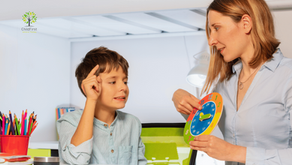Autism and Migraines/Headaches Explained for Adults with Autism
- ChildFirst Behavior Therapy

- Nov 19, 2023
- 6 min read
Updated: Dec 20, 2023

It is characterized by multiple symptoms and challenges related to social communication, repetitive behaviors, and restricted interests.
However, other factors can influence the well-being of individuals with autism, and one such factor is the experience of migraines and headaches.
In this article, we will delve into the connection between autism and migraines, explore why individuals with autism may be more susceptible to headaches, and discuss strategies to manage and alleviate this discomfort.
Migraines and Headaches: A Common Affliction
Migraines and headaches are widespread conditions that can affect anyone, regardless of their neurodevelopmental profile.
Various factors, including stress, lack of sleep, dietary choices, and environmental factors can trigger them.
These painful episodes can vary in intensity and duration, but they often disrupt daily life and well-being.
For individuals with autism, the experience of migraines and headaches can be particularly challenging.
The heightened sensitivities and sensory processing differences commonly found in people with autism may make them more vulnerable to these episodes.
Let's explore some of the reasons why migraines and headaches may be more prevalent in this population.
Sensory Sensitivities in Autism
One of the core characteristics of autism is sensory sensitivity.
Individuals with autism often have heightened or altered sensory perceptions, making them more sensitive to sensory stimuli, such as bright lights, loud noises, and strong smells.
These sensory sensitivities can extend to physical sensations as well, including pain.
For someone with autism, the pain experienced during a migraine or headache may be amplified due to their heightened sensory perceptions.
The discomfort can be overwhelming and challenging to manage.
As a result, individuals with autism may require different strategies and accommodations to address their sensory sensitivities during migraine episodes.
Communication Difficulties
Communication challenges are another hallmark of autism.
People with autism may have difficulty expressing their needs and discomfort in a way that is easily understood by others.
This can be especially problematic when experiencing a migraine or headache.
For instance, an individual with autism may not be able to articulate the nature and severity of their pain, making it difficult for caregivers or healthcare providers to provide appropriate assistance.
This can lead to frustration and misunderstandings, compounding the distress caused by the migraine or headache.
To address these communication challenges, it's crucial to develop alternative forms of communication, such as visual supports, sign language, or augmentative and alternative communication (AAC) devices, to enable individuals with autism to convey their discomfort effectively during migraine episodes.
Routine and Predictability
Individuals with autism often thrive on routine and predictability.
Sudden changes or disruptions in their daily schedule can be distressing.
Migraines and headaches, with their unpredictable onset and variable duration, can be particularly challenging for people who rely on routine to navigate their world.
The uncertainty of when a migraine or headache might strike can lead to increased anxiety for individuals with autism, as they may struggle to prepare for or adapt to these episodes.
Caregivers and support networks should be aware of this need for predictability and work with individuals with autism to develop strategies for managing and coping with the uncertainty of migraine attacks.
Co-Occurring Conditions
It's essential to recognize that autism often co-occurs with other medical and psychological conditions.
Some of these comorbid conditions may contribute to the increased prevalence of migraines and headaches in individuals with autism.
For example, anxiety and depression are common comorbid conditions among people with autism.
These mental health challenges can exacerbate stress levels, which are known triggers for migraines and headaches.
Identifying and addressing these co-occurring conditions is an essential part of managing migraines in individuals with autism.
Additionally, gastrointestinal issues, such as irritable bowel syndrome, are more prevalent in people with autism.
These digestive problems can also be associated with headaches and migraines.
It's crucial to recognize and address these gastrointestinal issues to alleviate migraine triggers.
Strategies for Managing Migraines and Headaches in Adults with Autism

Managing migraines and headaches in adults with autism requires a holistic and individualized approach.
Here are some strategies that can be effective in providing relief and support:
Visual Schedules: Visual schedules and supports can help individuals with autism anticipate and prepare for changes in their routine, including migraine episodes.
These schedules can include steps for self-care, like drinking water and resting in a quiet space.
Communication Aids: As mentioned earlier, alternative communication aids can be invaluable for autistic individuals during migraine episodes.
These aids can help them express their pain, discomfort, and needs clearly.
Sensory-Friendly Environments: Create a sensory-friendly environment by reducing sensory triggers like bright lights and loud noises.
Dimming the lights and using noise-cancelling headphones can help minimize sensory overload during migraines.
Medication Management: Work with healthcare providers to develop a medication plan for managing migraines.
It's essential to consider the specific needs and sensitivities of the individual with autism, as certain medications may have adverse effects.
Dietary Considerations: Consider nutritional triggers contributing to migraines, such as caffeine, processed foods, and artificial additives.
A well-balanced and nutritious diet can help reduce the frequency of migraine episodes.
Stress Reduction Techniques: Explore techniques well-suited to the individual's sensory profile.
This might include deep pressure therapy, mindfulness, or sensory integration exercises.
Comorbid Condition Management: Address and manage co-occurring conditions, such as anxiety, depression, and gastrointestinal issues, to reduce their impact on migraine frequency.
Regular Sleep Patterns: Establish and maintain standard sleep patterns to minimize sleep-related migraine triggers.
Individuals with autism often benefit from a structured sleep routine.
Hydration: Ensure the autistic individual stays well-hydrated, as dehydration can trigger migraines.
Please encourage them to drink water regularly throughout the day.
Professional Support: Seek the guidance of healthcare professionals, including neurologists, psychologists, and therapists, to develop a comprehensive plan for managing migraines and headaches in adults with autism.
Conclusion
Migraines and headaches are common afflictions that can affect individuals with autism, often due to their sensory sensitivities, communication difficulties, routine-based lifestyle, and co-occurring conditions.
However, with the proper support and strategies, it is possible to manage and alleviate these discomforts effectively.
Caregivers, family members, and healthcare providers need to work collaboratively to understand the unique needs and sensitivities of each individual with autism and tailor interventions accordingly.
By doing so, we can enhance the quality of life for adults with autism and provide them with the tools to manage migraines and headaches more effectively.
If you're seeking professional guidance and support for individuals with autism, consider contacting experts at Child First Behavior Therapy.
They specialize in applied behavior analysis (ABA) therapy and offer services to help individuals with autism reach their full potential.
To learn more about their services and how they can support you, visit their website at Child First Behavior Therapy.
Remember that every person with autism is unique, and the strategies that work best for managing migraines and headaches may vary from one individual to another.
By recognizing and addressing their specific needs, we can help autistic individuals lead fulfilling and pain-free lives.

FAQs
What is the connection between autism and migraines?
The relationship between autism and migraines is complex. People with autism may be more susceptible to migraines due to sensory sensitivities, communication difficulties, and co-occurring conditions.
Do all individuals with autism experience migraines?
No, not all individuals with autism experience migraines. The prevalence varies among individuals, just as in the general population.
How can I tell if an individual with autism is experiencing a migraine or headache?
Recognizing migraine symptoms in individuals with autism can be challenging due to their communication difficulties. Look for changes in behavior, signs of discomfort, or alternative communication methods to express pain.
What are common triggers for migraines in adults with autism?
Common triggers may include sensory sensitivities, stress, changes in routine, co-occurring conditions, and dietary factors.
Are there specific medications for treating migraines in individuals with autism?
Medication choices should be made in consultation with a healthcare provider. Some individuals with autism may need tailored medication plans due to their unique sensitivities and needs.
How can I create a sensory-friendly environment during a migraine episode?
Dimming lights, reducing noise, providing a quiet and comfortable space, and using sensory tools like weighted blankets can create a sensory-friendly environment.
What are the dietary considerations to prevent migraines in adults with autism?
Encourage a well-balanced diet and pay attention to potential triggers such as caffeine, processed foods, and artificial additives.
Can anxiety and depression worsen migraines in individuals with autism?
Yes, anxiety and depression, which are common co-occurring conditions in autism, can exacerbate stress levels and increase the frequency of migraines.
Are there any alternative therapies or interventions to manage migraines in adults with autism?
Some benefit from alternative therapies like deep pressure therapy, mindfulness, or sensory integration exercises. Consult with healthcare professionals to explore suitable options.
How can I help an individual with autism communicate their migraine pain?
Utilize alternative communication aids such as visual supports, sign language, or augmentative and alternative communication (AAC) devices to help them express their discomfort clearly.







Comments